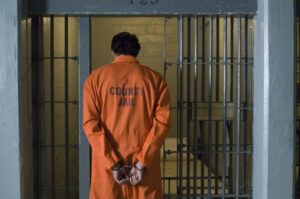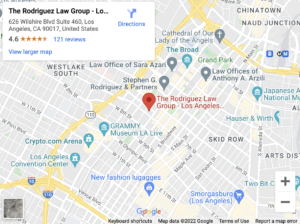Culver City Jail
 The Culver City Police Department operates a jail for its arrestees. Specifically, if you get arrested by a police officer in Culver City, you will probably end up spending at least some time in Culver City Jail.
The Culver City Police Department operates a jail for its arrestees. Specifically, if you get arrested by a police officer in Culver City, you will probably end up spending at least some time in Culver City Jail.
The state classifies the jail as a class I facility. This means it can only hold inmates temporarily. And since the facility has only 30 beds, you will probably not spend much time in the jail before you either get released or get transferred to another jail facility.
What Is the Culver City Jail?
 Culver City’s jail is in the Culver City Police building located at 4040 Duquesne Ave. The jail is on Duquesne Ave. between Culver Blvd. and Braddock Dr. The police department sits next to Culver City Hall. When you visit the jail, you can park in the parking garage for the city hall. You can also park on Duquesne Ave. at a parking meter.
Culver City’s jail is in the Culver City Police building located at 4040 Duquesne Ave. The jail is on Duquesne Ave. between Culver Blvd. and Braddock Dr. The police department sits next to Culver City Hall. When you visit the jail, you can park in the parking garage for the city hall. You can also park on Duquesne Ave. at a parking meter.
Culver City pays for the jail, and the Culver City Police Department’s Special Operations Bureau operates it. In other words, the department employs all the officers who deal with the jail’s inmates.
The jail has 30 beds. It holds both male and female inmates, although they are held in separate areas.
Who Goes to the Culver City Jail?
People arrested by the Culver City Police Department go to Culver City Jail. But not everyone arrested in Culver City will go to the city jail. Arresting officers from the Los Angeles County Sheriff’s Department (LASD) or the California Highway Patrol often transport arrestees to one of the LASD’s jail facilities.
Officers must make an arrest to transport someone to the jail. This typically happens in two ways.
First, patrol officers might see a criminal violation or get dispatched for a service call. They will conduct an initial investigation and arrest someone if they have probable cause to believe they committed a crime.
For example, suppose that a shop manager reports a robbery. While responding to the call, the investigating officers spot someone running from the area carrying what appears to be stolen merchandise. Once the shop owner identifies the suspect, the officers may have probable cause to make an arrest for robbery.
Keep in mind that this does not necessarily mean the officers caught the right person. The arrestee will have an opportunity to present a criminal defense to the robbery charges, such as a defense of mistaken identity. But before this happens, the arrestee will get booked into the Culver City Jail.
Second, someone can get arrested according to an arrest warrant. This often happens when the officers cannot develop enough evidence to arrest suspects. Instead, they turn the case over to a police detective, who continues the investigation.
Suppose that the police respond to a homicide call. Detectives will use eyewitness testimony and physical evidence, such as fingerprints and DNA samples, to narrow down the possible suspects. The detectives might develop enough evidence to apply for an arrest warrant from a judge.
How to Get Someone Out of Culver City’s Jail System
Culver City Jail is a temporary holding facility. It can only detain arrestees for up to 96 hours, equivalent to four days, although exceptions can happen when someone gets arrested on weekends or holidays.
During this time, the arrestee can get released if the charges are dropped, or the prosecutor chooses not to file charges after reviewing the police investigation. This rarely happens. Instead, the most likely next step involves a court hearing.
Within 96 hours, the arrestee should see a judge for an arraignment and bail hearing. At the arraignment, the judge informs the arrestee of the charges filed against them. They enter a plea of guilty or not guilty in response.
The judge then conducts a bail hearing, where the judge will consider the charges and determine whether to:
- Release the arrestee without bail, also called a release on recognizance
- Require bail for release
- Hold the arrestee without bail
To choose one of these options, the judge will weigh the severity of the crime and the likelihood that the arrestee will show up for trial. Judges tend to place greater conditions on arrestees with a greater incentive to flee instead of facing their charges.
Release on Recognizance
For misdemeanor offenses, California law favors release on recognizance which requires the court to release a defendant without requiring bail. However, a judge could make a special finding that such a release for this defendant will either endanger the public or fail to secure the defendant’s appearance at trial.
For example, in a misdemeanor shoplifting case, the judge might impose bail and other release conditions if the defendant failed to appear in court after prior arrests. Similarly, a defendant arrested for misdemeanor domestic battery might not receive release on recognizance if they have made threats against the victim during the arrest.
If a judge grants release on recognizance, the Culver City jail will release the inmate after they sign an agreement to return to court.
Release on Bail
California law allows a judge to grant bail in most cases. However, bail will likely be denied for crimes such as intentional homicide. Los Angeles County has two bail schedules — one for felonies and the other for misdemeanors and infractions — that give the presumptive bail for an offense. Judges almost always follow these schedules because they must explain any deviations from them.
When a judge imposes bail, the inmate must post security for their release in one of two ways. First, you can ask a friend or family member to deposit the bail money with the court. This is often a good option if the bail amount is low enough that you can afford to pay it.
If you cannot afford to pay your bail, you can pay a bail bond agent to secure the appearance. To do this, you pay a fee to the bail bondsman, who promises the court that you will make all your court dates. If you fail to appear, the bail agent must either return you to jail or pay the full bail amount to the court.
Hold Without Bail
A judge must hold inmates without bail in capital cases. They can also hold defendants without bail in lesser cases when they believe that the defendant will not appear in court or poses a danger to the community or the victims of the crime.
What Can a Los Angeles Criminal Defense Lawyer Do for Someone in Culver City Jail?
Lawyers can intervene at several points to help you avoid jail. First, a lawyer can meet with the police and prosecutors before an arrest to prevent you from going to jail. Second, your lawyer can persuade prosecutors to drop charges or refrain from filing charges against you. Finally, your lawyer can appear at your bail hearing to secure your release.
Contact our lawyers at The Rodriguez Law Group Los Angeles Criminal Defense Attorneys to learn about your options for getting someone released from Culver City Jail. You can call us today at (213) 995-6767.


